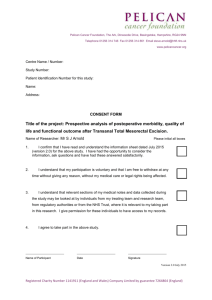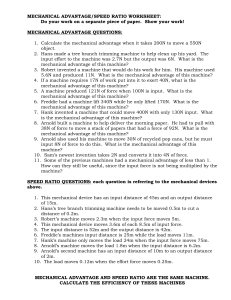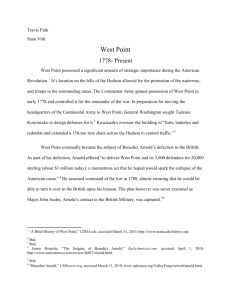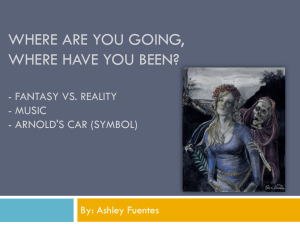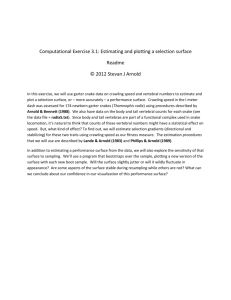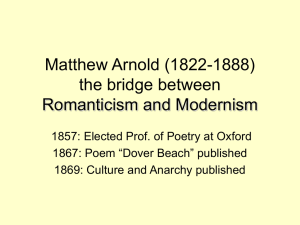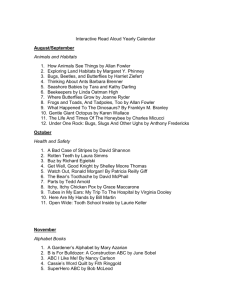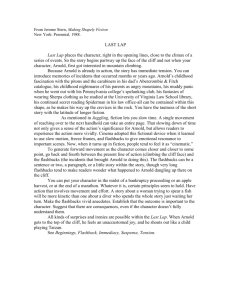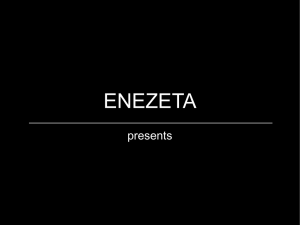From Arnold to Eagleton to Oehlschlaeger: 'Sweetness and Light' in
advertisement
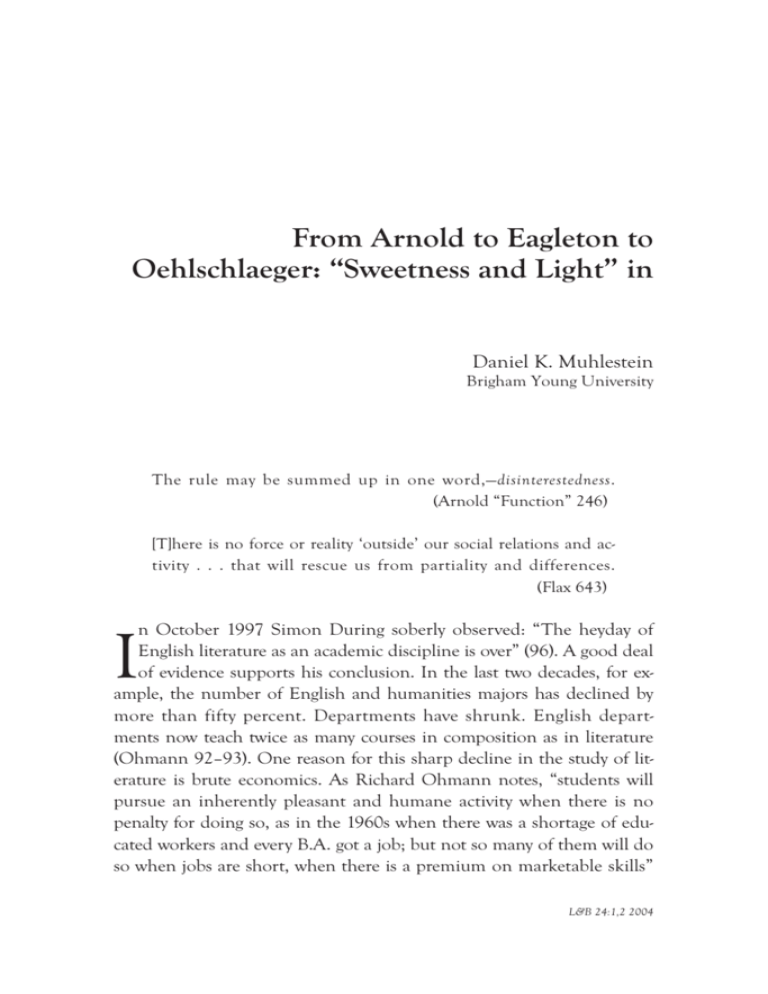
From Arnold to Eagleton to Oehlschlaeger: “Sweetness and Light” in Daniel K. Muhlestein Brigham Young University The rule may be summed up in one word,—disinterestedness. (Arnold “Function” 246) I [T]here is no force or reality ‘outside’ our social relations and activity . . . that will rescue us from partiality and differences. (Flax 643) n October 1997 Simon During soberly observed: “The heyday of English literature as an academic discipline is over” (96). A good deal of evidence supports his conclusion. In the last two decades, for example, the number of English and humanities majors has declined by more than fifty percent. Departments have shrunk. English departments now teach twice as many courses in composition as in literature (Ohmann 92–93). One reason for this sharp decline in the study of literature is brute economics. As Richard Ohmann notes, “students will pursue an inherently pleasant and humane activity when there is no penalty for doing so, as in the 1960s when there was a shortage of educated workers and every B.A. got a job; but not so many of them will do so when jobs are short, when there is a premium on marketable skills” L&B 24:1,2 2004 (93). Another reason has been a dramatic shift in scholarly interest from text to image and from text to context, with literature departments reconfiguring themselves to focus on film theory, media studies, and cultural studies generally (Richter 28–29). A third reason, however, is neither economic nor instrumental. It is, rather, philosophical and epistemological. In the last thirty years one of the most effective evaluations of higher education has been the postmodern critique of the traditional justification of the study of literature, a justification which finds its fullest expression in the writings of that apostle of culture, Matthew Arnold. So devastating has it been that professors of literature in effect have very nearly argued themselves out of their jobs, for as George Levine wryly observes, the critics who have cast off Arnold’s defense of literature have yet to explain why one should continue to study the texts Arnold valued. Such critics, Levine notes, “have not been able or willing to account . . . for their own continuing preoccupation with the texts that are being exposed as imperialistic, sexist, homophobic, racist, and in most respects ideologically pernicious” (“Reclaiming” 382). Given the stakes in the debate, to review Arnold’s justification of the study of literature, discuss the many and varied reasons why postmodern critics have rejected Arnold’s position, and analyze the adequacy of those few contemporary writers who have come to Arnold’s defense seem worthwhile. Such a review discovers, interestingly enough, that the thin defense of “Sweetness and Light” that runs from Arnold to the present culminates in the work of a handful of Christian apologists whose traditions and doctrines Arnold sought to replace. “When established beliefs are brought into question, when all creeds, dogmas, and traditions seem to be failing, where can one turn for consolation and support?” (Kaplan 333). To Matthew Arnold, the answer to that question is simple: literature. People read literature, Arnold declares, in order “to know the best that is known and thought in the world” (“Function” 246). To do so, they must be discriminating in both what and how they read: “We must accustom ourselves to a high standard and to a strict judgment” (Arnold “Study” 307). Readers must also be willing to set aside both their “historic” and their “per- sonal” estimates of literature. To Arnold the historic estimate occurs when readers value a text simply because of its historical significance; the personal estimate occurs when they allow their “personal affinities, likings, and circumstances . . . to sway [their] estimate” of the quality and value of a given text (“Study” 308). Both must be set aside in favor of what Arnold calls the “touchstone” method of analysis: “there can be no more useful help for discovering what poetry belongs to the class of the truly excellent than to have always in one’s mind lines and expressions of the grand masters, and to apply them as a touchstone to other poetry” (311). Above all else, Arnold concludes, in the search for “the best that is known and thought in the world” readers must show “disinterestedness,” by which he means that in the search for truth they must be willing to set aside the practical consequences of accepting or rejecting the particular idea or concept under consideration: The rule may be summed up in one word,—disinterestedness. And how is criticism to show disinterestedness? By keeping aloof from what is called “the practical view of things.” . . . By steadily refusing to lend itself to any of those ulterior, political, practical considerations about ideas, which plenty of people will be sure to attach to them. . . . Its business is . . . simply to know the best that is known and thought in the world. . . . Its business is to do this with inflexible honesty, with due ability; but its business is to do no more, and to leave alone all questions of practical consequences and applications. (“Function” 246) Touchstones, strict judgment, disinterestedness, high seriousness: these are the cornerstones of Arnold’s approach to literature. They are his way of discovering and reproducing what he in Culture and Anarchy (1869) calls “Sweetness and Light” (408). They embody a set of assumptions which Arnold inherited from the Enlightenment: both meaning and aesthetics are inherent in a text, methodology can serve as an important check against subjectivity, truth is available to the serious scholar, etc; and for well over a hundred years, Arnold’s assump- tions and methods have provided the rationale for the traditional defense of the study of the literary canon, differing versions of which defense run from Arnold to T. S. Eliot to Allan Bloom to William J. Bennett. In the last two decades, however, at least three of the cornerstones of Arnold’s defense of literature have been called into question. The first is Arnold’s notion of beauty, his assumption—to use current terminology—of an inherent aesthetics. Some texts, he suggests, are simply more beautiful than others, a fact which is—or should be—manifest on its face: Critics give themselves great labor to draw out what in the abstract constitutes the characters of a high quality of poetry. It is much better simply to have recourse to concrete examples;—to take specimens of poetry of the high, the very highest quality, and to say: The characters of a high quality of poetry are what is expressed there” (“Study” 313). Not so, responds Barbara Herrnstein Smith: beauty is never just in the text; rather, “what may be spoken of as the ‘properties’ of the work . . . are not fixed, given, or inherent in the work ‘itself’ but are at every point the variable products of some subject’s interaction with it” (148). Some texts, Smith continues, simply strike it rich; they happen upon a community of readers who decide to constitute the text as a thing of beauty. Such a text starts out with an immediate survival advantage over its potential competitors: “it will not only be better protected from physical deterioration but will also be more frequently . . . read or recited, copied or reprinted, translated, imitated, cited, and commented upon—in short culturally re-produced” (148). Once a text is thus canonized, critics will work day and night if need be to protect it from the threat of cultural extinction. They will background those features that would, in a noncanonical work, be viewed as being technically crude or philosophically naïve. They will gloss over those parts of the text’s ideology which might offend a modern sensibility. They will emphasize the ways in which the text now performs the functions of a canonical work per se, “as a stylistic and generic exemplar that will energize the production of subsequent works and texts (upon which the latter will be modeled and by which, as a normative ‘touchstone,’ they will be measured)” (150). In short, Smith concludes, readers never discover beauty in a text; rather, they designate a text as a thing of beauty and then enforce that designation. Of course, the assertion of an inherent aesthetics is not the only part of Arnold’s program under attack today. The search for truth is as well. Like beauty, truth is now in disrepute. It is generally viewed as a construct rather than an absolute, a mechanism of control rather than a tool of liberation. For example, Jane Flax observes that “Post-modern discourses are all ‘deconstructive’ in that they seek to distance us from and make us skeptical about beliefs concerning truth, knowledge, power, the self, and language that are often taken for granted within and serve as legitimation for contemporary Western culture” (624). The search for absolute truth, Flax maintains, is a vestige of Enlightenment thinking which must be rejected. Thus, all perspectives, including Flax’s own, are necessarily partial, incomplete, situated. “[T]here is no force or reality ‘outside’ our social relations and activity,” she writes, “that will rescue us from partiality and differences” (643), and previous claims for universal truth “now appear . . . to mask the embeddedness and dependence of the self upon social relations . . . . [A]ll such transcendental claims reflect and reify the experience of a few persons—mostly white, Western males” (626). Little wonder, then, that for critics like Flax, the goal is not to discover “the best that is known and thought in the world” but rather to take the ax to the root of civilization itself. “If we do our work well,” Flax concludes, “‘reality’ will appear even more unstable, complex, and disorderly than it does now. In this sense, perhaps Freud was right when he declared that women are the enemies of civilization” (643). Not all postmodern theorists are as radical as Flax, of course. But versions of her rejection of the “trace of truth” exist in the work of critics ranging from Bonnie Spanier to Gerald Graff to Stanley Fish. Not surprisingly, most such critics are particularly leery of Arnold’s notion of “disinterestedness.” Terry Eagleton’s explanation of his claim that “there is no possibility of a wholly disinterested statement” is a case in point (13). The literary canon, Eagleton observes, “has to be recognized as a construct, fashioned by particular people for particular reasons at a certain time. There is no such thing as a literary work or tradition which is valuable in itself ” (11). Further, Eagleton continues, the canon was constructed by critics who had a significant stake in the process: “Their critical responses were deeply entwined with their broader prejudices and beliefs. This is not a matter of blame: there is no critical response which is not so entwined and thus no such thing as a ‘pure’ literary critical judgment or interpretation” (15). But though no blame can be attached to interested criticism, those who claim to be disinterested are wrong at best and pernicious at worst. They maximize their influence by masking the necessary connection among literature, criticism, ideology, and power—a connection which has generally worked to their advantage: What we have uncovered so far, then, is not only that . . . the value-judgments by which [literature] is constituted are historically variable, but that these value-judgments themselves have a close relation to social ideologies. They refer in the end not simply to private taste, but to the assumptions by which certain social groups exercise and maintain power over others. (16) Beauty, truth, disinterestedness: these, then, are three aspects of Arnold’s defense of literature which contemporary critics have called into question. The critiques of Arnold’s views on them are also symptomatic of a more fundamental difference between Arnold and his postmodern critics: he is a foundationalist; they are not. A foundationalist, observes Fish, attempts to ground inquiry and communication in something more firm and stable than mere belief or unexamined practice. The foundationalist strategy is first to identify that ground and then so to order our activities that they become anchored to it and are thereby rendered objective and principled. (Doing 342) Potential foundations have included the self, universal human nature, God, a set of eternal values, the material world, reason, and so forth. Thus, for a Christian believer, God, as embodied in God’s word, is the foundation from which spring all truth and knowledge; for a scientist, the rules of reason and logic are foundational, particularly as expressed in the scientific method; and for Arnold, the touchstones of literature are the originating standards of taste and judgment, foundations best approached in a spirit of critical disinterestedness. Not surprisingly, most postmodern critics are anti-foundationalists: Anti-foundationalism teaches that questions of fact, truth, correctness, validity, and clarity can neither be posed nor answered in reference to some extracontextual, ahistorical, nonsituational reality, or rule, or law, or value; rather, anti-foundationalism asserts, all of these matters are intelligible and debatable only within the precincts of the contexts or situations or paradigms or communities that give them their local and changeable shape. (Fish Doing 344) The most influential practitioners of anti-foundationalism are the advocates of what is often called “identity politics.” Critics who practice identity politics ask important questions about groups of people who have been historically underrepresented in the traditional canon, including women, men and women of color, working-class men and women, and gays and lesbians. At first glance, such critics appear to be engaged in a genuinely foundationalist enterprise, the foundation being the relevant category: gender, race, class, or sexual orientation. In fact, in the early years of the movement various identity politics critics practiced a kind of baseline essentialism: for Elaine Showalter, that baseline was the reality of a woman’s lived experience (141); for Julian Jayfield and James Emanuel, it was, to borrow Hoyt Fuller’s memorable phrase, “the bosom of their blackness” (qtd. in Emanuel 214); and for Adrienne Rich, it was a woman’s orientation toward other women (141–46). Indeed, so pronounced was this early strain of essentialism that it pro- voked countercharges of race- and sex-based bigotry, with critics such as Susan Haack observing that the claim that “there are black or female or homosexual ‘ways of knowing’ . . . seems to me not only false, but of the essence of racism and sexism” (141). Today, however, the tide has turned. Foundations and essentialism are generally seen as hindrances to the cause. bell hooks sums up the current state of affairs better than most. She contends that although historically many African-American writers and critics have been unenthusiastic about postmodern theory, postmodern critiques of identity are particularly useful in the struggle for black liberation. Critiquing the essentialist aspects of identity formation, she says, allows African Americans to resist more easily the attempts by others to impose upon them a narrow, constricting notion of blackness (628). The theory of a constructed self also helps African Americans to understand the interaction between race and class better, to see more clearly how class mobility has altered collective black experience (629). The same theory also enables African Americans more fully to explore, understand, and attempt to change the concrete economic and social circumstances by which they are oppressed. “Abandoning essentialist notions,” hooks concludes, “would be a serious challenge to racism” (629). What is true for hooks is true for many other practitioners of identity politics today. To them essentialism is bunk. Consciousness is a social construct. There are no universal truths, no foundations, no touchstones, and no disinterestedness. Arnold’s dusty Victorian justification of the study of literature is long dead. This general acceptance of anti-foundationalism is perhaps best summarized by Gertrude Himmelfarb, who, although she is speaking of historians in specific, nevertheless accurately characterizes what might be called the spirit of the age: [S]ome of the basic tenets of postmodernism have pervaded the profession to the point where most young historians, and a good many older ones, are accepting those ideas almost unconsciously. Above all they share the radical skepticism and relativism of postmodernism: a denial that there is any such thing as knowledge, truth, reason, or objectivity, and a refusal even to aspire to such ideals, on the ground that they are not only unattainable but undesirable— that they are indeed authoritarian and repressive. (86) Still, not everyone has been willing to abandon the search for disinterestedness, beauty, truth, and foundations, though some responses have been less productive than others. For example, some critics have reacted to the postmodern dilemma by repeating the claims of postmodern theory in loud and strident voices, as though the mere description of a position were somehow sufficient for its critique. Richard Kimball’s Tenured Radicals: How Politics Has Corrupted Higher Education (1988) is an obvious example of this “turn up the volume” approach. What it lacks in substance, it attempts to make up for in decibels. Unfortunately, it also illuminates without persuading: it is praised by those who already subscribe to Kimball’s opinion but is taken as a sign of weakness by almost everyone else, including those who are as yet undecided. Another alternative has been to critique postmodern thought by emphasizing the high cost of accepting it. This second approach, according to Fish, usually takes the form of a counterattack in which the supposedly disastrous consequences of anti-foundationalism are paraded as a reason for rejecting it. Those consequences are usually said to extend to the loss of everything necessary for rational inquiry and successful communication. (Doing 345) Like the “turn up the volume” approach, however, this alternative has ultimately proven unsatisfactory. Part of the problem is that such a response suffers from what Marguerite Waller once called “Academic Tootsie.” The film Tootsie, Waller observes, is something of a contradiction. On one hand, its content includes a critique of gender roles and stereotypes, while, on the other hand, the film’s cinematography reinforces the very gender constructs its content seeks to disrupt (Waller 2–3). Its method, that is to say, systematically undercuts its content. Unfortunately, much the same thing can be said of those critics who at- tempt to discredit postmodern thought by highlighting its cost, for in attempting to defend disinterestedness as a concept such critics necessarily abandon disinterestedness as a method, focusing on precisely those practical consequences which Arnold said disinterested critics must assiduously ignore: “And how is criticism to show disinterestedness? . . . By steadily refusing to lend itself to any of those ulterior, political, practical considerations about ideas, which plenty of people will be sure to attach to them (“Function” 246). A third response has been to point out the inconsistencies in postmodern thought, usually by emphasizing the foundationalist aspects of anti-foundationalism. For example, Haack observes that while all contextualists believe that epistemic standards differ from culture to culture, not all believe that there is no way to judge between competing standards: while “real relativists” assert that there is no adequate way to judge between the standards of evidence developed by different cultures since any method of judgment would itself be culturally defined, “tribalists” are “committed to the claim that their, non-‘Western,’ standards are privileged” (145). In arguing for the superiority of their own particular standards, Haack continues, tribalists reject the grounding assumption of contextualism itself. Further, even true relativists are not really contextualists, since the assertion that standards of better and worse evidence are culture-bound is itself an anti-contextualist claim: it asserts a “truth” which transcends cultures in that it is said to be true of every culture. It is, in short, a foundationalist claim (145–46ff). The problem with Haack’s argument is not that it is false, but rather that it is true but irrelevant, for while highlighting the foundations of anti-foundationalism is good fun, in the end it merely demonstrates what the Derridian version of anti-foundationalism has claimed all along: every system makes an ultimate, necessary appeal to foundational presence. Although proving this truth in the case of antifoundationalism certainly reveals the fact that the anti-foundationalists are a most inconsistent bunch, that observation loses its persuasive force because to anti-foundationalists consistency is no virtue and inconsistency no vice. A fourth response to the postmodern rejection of the Arnoldian problematic has been a vigorous reassertion of the truthfulness of Arnold’s position, the most famous example probably being To Reclaim a Legacy, which was written in 1984 under the direction of then Secretary of Education William J. Bennett. To be sure, Bennett repeatedly emphasizes the practical consequences of postmodernism, concluding that the emergence of postmodern thought in universities has helped “condemn the humanities to irrelevance,” has caused students to “vote with their feet, stampeding out of the humanities departments” (16), and has produced a generation of graduates who lack discernment, judgment, wisdom, or standards: “Being well-rounded is not enough if, after all the sharp edges have been filed down, discernment is blunted and the graduate is left to believe without judgment, to decide without wisdom, or to act without standards” (7). In addition to emphasizing the negative consequences of adopting a postmodern perspective, however, Bennett also energetically reasserts the validity of Arnold’s view of the world. There is such a thing as truth, he asserts, and truth can and should be the province of the humanities. “The humanities,” he writes, “are not an educational luxury, and they are not just for majors. They are a body of knowledge and a means of inquiry that convey serious truths, defensible judgments, and significant ideas” (8). Furthermore, the core texts in the humanities should continue to be the traditional canon, supplemented by such political documents as the Declaration of Independence, The Federalist, the Constitution, and so forth. “Why these particular books and these particular authors?” he asks, and answers himself: “[b]ecause an important part of education is learning to read, and the highest purpose of reading is to be in the company of great souls” (11). The ultimate purpose of the humanities, Bennett concludes, is thus to introduce these great souls, these cultural touchstones, to students; then, and only then, will “each college and university . . . recognize and accept its vital role as conveyor of the accumulated wisdom of our civilization” (29–30). Bennett speaks with considerable passion, and he advocates a return to “Sweetness and Light” in no uncertain terms. What he does not do, however, is provide substantive support for his Arnoldian perspective. Rather than analyzing the strengths and weaknesses of his opponent’s positions, Bennett simply attacks them ad hominem, and rather than demonstrating the superiority of canonical texts, he simply asserts it de facto, relying in the end on the questionable authority of an informal survey tabulated in a newspaper column and the fact that when he invited several hundred educational and cultural leader to recommend ten books that any high school graduate should have read . . . four—Shakespeare’s plays, American historical documents . . . The [sic] Adventures of Huckleberry Finn, and the Bible—were cited at least 50 percent of the time. (10) Consequently, To Reclaim a Legacy has turned out to be more controversial than influential. Praised by those who were converts already, it has failed to turn the tide of either scholarly or general opinion, and it has proven to be particularly susceptible to scholarly critique, as evidenced by a stinging response, Speaking for the Hu-manities (1989), from Levine and others. But where Bennett failed, Allan Bloom succeeded—in selling power, if not in persuasiveness. Bloom’s The Closing of the American Mind (1988) made him a celebrity, a millionaire, and an unofficial spokesman for the claims of Enlightenment reason. In his first chapter Bloom provides a detailed historical analysis of the circumstances under which relativism, the popular version of anti-foundationalism, became the governing ideology in American universities. For most civilizations throughout history, Bloom argues, ethnocentrism was the norm. In a sense, ethnocentrism seemed necessary, for different cultures needed to believe in their own superiority in order to be content and in order to be motivated to work for and defend their people. The Greeks, however, began to reject ethnocentrism. Instead of assuming that their own culture was best, they reasoned that no one culture was perfect and that perfection, the truest form of the good, existed in bits and pieces in a variety of cultures. In order to discover and embrace that perfection, one needed to be open to the claims of competing cultures and to be willing to submit both one’s own culture and the cultures of others to the tribunal of reason. For both the Greeks and subsequent western tradition based upon Greek philosophy, then, the search for the good came to entail both cultural openness and a willingness to use reason to critique and correct prejudice. In America such openness led to an acceptance of the doctrine of “natural rights,” including those of life, liberty, and the pursuit of happiness. Unfortunately, there existed in America, as in all other countries, a substantial gap between the ideals of “natural rights” and “equality under the law” and the lives of ordinary men and women, the most obvious and pernicious example being slavery. Of course, one possible response to this gap between American ideals and American reality could have been, and in Bloom’s view should have been, to persuade the country to live up to its own best ideals. In fact, this was the response attempted by most early participants in the civil rights movement, including Martin Luther King, Jr. For many subsequent civil rights activists, however, the attempt to bring about change by way of the “natural rights” argument was deemed both too slow and inefficient and a convenient way to sidetrack what they saw as a revolution. Consequently, various groups (such as the Black Power movement) developed a new way to deal with prejudice and in the process a new kind of “openness.” The key, black activists said, was not to claim that everyone had rights by virtue of their status as individuals but, rather, to claim that they had rights by virtue of their status as minorities, as members of a repressed group. This elevation of the status of minorities was paralleled by a corresponding devaluation of the status of the majority. The majority was said to have no right to judge the minority, and openness was redefined not as a willingness to judge both self and others on the basis of reason but as an unwillingness to judge at all. Openness, that is to say, became relativism, which is now viewed as our one moral virtue: Openness—and the relativism that makes it the only plausible stance in the face of various claims to truth and various ways of life and kinds of human beings—is the great insight of our times. The true believer is the real danger. The study of history and of culture teaches that all the world was mad in the past; men always thought they were right, and that led to wars, persecutions, slav- ery, xenophobia, racism, and chauvinism. The point is not to correct the mistakes and really be right; rather it is not to think you are right at all. . . . The recent education of openness . . . is [to be] open to all kinds of men, all kinds of life-styles, all ideologies. There is no enemy other than the man who is not open to everything. (Bloom 26–27) In Bloom’s opinion, the cost of this new kind of openness is very high indeed. Because of it, America has lost the best motivation to study, that is, the desire to discover truer ways to live. It has become surprisingly indifferent to real cultural differences. This in turn has created an odd kind of American conformity: no one, after all, can teach a new truth. Finally, America has eliminated one of the very best ways of critiquing its own cultural bias: I know that men are likely to bring what are only their prejudices to the judgment of alien peoples. Avoiding that is one of the main purposes of education. But trying to prevent it by removing the authority of men’s reason is to render ineffective the instrument that can correct their prejudices. . . . Historical and cultural relativism actually are a means to avoid testing our own prejudices. (40) America’s salvation, Bloom concludes, is to go back to an earlier form of openness: the willingness to judge self and others alike, using reason as the standard of judgment, to go back, in short, to an Arnoldian view of the world: Thus there are two kinds of openness, the openness of indifference—promoted with the twin purposes of humbling our intellectual pride and letting us be whatever we want to be, just as long as we don’t want to be knowers—and the openness that invites us to quest for knowledge and certitude, for which history and the various cultures provide a brilliant array of examples for examination. This second kind of openness encourages the desire that animates and makes interesting every serious student—“I want to know what is good for me, what will make me happy”—while the former stunts that desire. (41) Seriousness, knowledge, certitude, truth, the good: these, then, are Bloom’s and Arnold’s answers to the postmodern dilemma. What is most surprising about The Closing of the American Mind is the fact that, against all expectations, the book became a runaway best seller. Less surprising is the speed with which both the book and its author became subjects of vigorous and sometimes venomous critique, with dozens of articles and at least two anthologies being written in response to his polemic. Though many of those responses contain more heat than light, Bloom’s attempt to reassert the claims of Enlightenment reason nevertheless turns out, upon reflection, to be less than satisfactory. Part of the problem is that, like Kimball’s, Bloom’s tone is often strident. For a man who claims to value fairness, Bloom seems notably unfair; and for a man who argues for the importance of submitting one’s own prejudices to the tribunal of reason, he comes across as both unreasonable and intractable—a tendency even his supporters acknowledge and lament.1 Another part of the problem is that, like Bennett, Bloom undercuts his own message: he makes the case against postmodernism by highlighting the negative consequences that have come from accepting it: relativism flatters people, strips them of better judgment, makes them bad students and worse citizens, etc. Thus, like Bennett, Bloom suffers from an advanced case of “academic tootsie.” For a man advocating the importance of disinterested inquiry, he makes his case in a scandalously interested manner. A final part of the problem, and this part is the most important, is that Bloom presents causal analysis as though it were epistemology. His description of the historical forces and circumstances which produced the postmodern love affair with relativism is compelling reading—compelling but irrelevant. The question should not be “What historical forces produced For a good sampling of responses to Bloom, see Essays on ‘The Closing of the American Mind’ (1989), edited by Robert L. Stone, and Beyond Cheering and Bashing: New Perspectives on ‘The Closing of the American Mind’ (1992), edited by William K. Buckley and James Seaton. 1 and privileged relativism?” Rather, it should be “Is relativism true? ” Proving the historical necessity behind the adoption of relativism is not the same thing as proving the inadequacy of that position. If that were the case, if proving the necessity behind a theory were sufficient to disprove the theory itself, then Bloom would have simultaneously disproved his own version of openness as well. After all, he gives a quite compelling account of the historical forces and circumstances which produced it, too. In view of the difficulties faced by the preceding attempts to defend Arnold from the slings and arrows of postmodern criticism, perhaps a more modest, piecemeal approach might be in order, one that combines insights from critics as disparate as Eugene Goodheart, Haack, Levine, Reed Dasenbrock, Richard Etlin, David Bromwich, and Rob-ert Alter. Goodheart’s limited defense of objectivity is perhaps a good place to start. He rejects the notion of a determinate and unitary truth. Simultaneously, however, he mounts a spirited defense of at least the ideal of disinterested objectivity. “[O]bjectivity or the appeal to it,” he writes, “is inescapable in any forum in which ideas are argued and debated. If that were not the case, the intellectual enterprise would be impossible. Since disagreements could never be overcome by an appeal to fact or reason, why would one bother to engage in reasoned debate?” (14). Further, the fact that everyone operates from within an interested perspective does not, of itself, eliminate disinterestedness as a possible motive and method. All that is needed is a subjective desire for objectivity, an interested desire for disinterestedness: “value-laden statements,” Goodheart declares, “allow for objectivity. A person is not prevented from objectively pursuing injustice by his passion for justice. Disinterestedness in a judge is a means of rising above prejudice to discover the truth and administer justice” (13–14). Like Goodheart, Haack believes that motivated interest can create the equivalent of disinterested analysis. Building upon that perspective, Haack identifies at least one social practice by means of which such transformations are facilitated. Like Goodheart, she does not deny the power of context to shape perception; neither does she posit some idealized vantage point outside of systemic constraints from which truth might be discovered. Rather, she argues precisely the opposite—that context, interest, desire, and politics are what make the discovery of truth possible, and that the mechanism by which enlightenment comes is the marketplace of ideas: [T]hese observations about the epistemic interdependence of knowing subjects and the social character of scientific inquiry, rather than suggesting the conclusion that knowledge is inherently political, suggest, on the contrary, that one of the . . . mechanisms by means of which bias gets detected and corrected—in scientific theorizing, and, though less systematically, in inquiry generally—is by means of competition between supporters of rival theories or approaches. (145–46) Of course to speak of the marketplace of ideas is to gesture toward the institution within which that marketplace is said to flourish: the university. To a critic like Levine, although the university is not disinterested, it is not entirely interested, either. Rather, at its best a university is a contested utopian space in which freedom struggles against political control. “Although utopia is nowhere, and certainly not here,” Levine writes, “the space of critical work within the university [is] . . . potentially very different from the spaces in which the battles of economics and politics, class and gender get fought out instrumentally and daily” (“Reclaiming” 385). This contested utopian space “invariably encourages what is normally disallowed: a sense of the real complications of simplified and mystified issues and the voicing of unpopular and repressed ideas and values” (384). Aesthetics in particular facilitates the exploration of alternative voices and perspectives. “The aesthetic,” Levine observes, remains a rare if not unique place for almost free play, a place where the very real connections with the political and the ideological are at least partly short circuited. . . . The aesthetic is not outside of politics. . . . But it makes its way by indirection and by infusing all questions with affect and value. (385) Indeed, the aesthetic is a realm where something like disinterest and impersonality are possible. . . . There are degrees of interest, and . . . the very political stances that so many of the works of cultural study espouse are possible only in that they are felt to emerge disinterestedly, from a clear-eyed view of the way things are. (385) To these three limited defenses of truth, objectivity, disinterestedness, and aesthetics, four further defenses might profitably be added. The first is Dasenbrock’s response to Fish’s version of conceptual relativism. In “How to Recognize a Poem When You See One,” Fish relates a by now famous story about the ease and proficiency with which his students interpreted a list of authors (the reading assignment for a previous class) as a religious poem. The students, Fish argues, did not misread, misunderstand, or misinterpret the list when they interpreted it as a poem, simply because the list had no inherent meaning to misread in the first place. Readers, that is to say, do not “decode” texts; rather, “they make them” (Fish “How” 271). In poetry, for example, students are taught what constitutes a poem (ambiguity, complexity, a text in which every word is important, and so forth); they are given a text and told, “This is a poem; interpret it”; and they then read into the text the precise characteristics they have previously been taught are a part of poetry. In doing so, they literally create the poem’s meaning: It is not that the presence of poetic qualities compels a certain kind of attention but that the paying of a certain kind of attention results in the emergence of poetic qualities. . . . Skilled reading is usually thought to be a matter of discerning what is there, but if the examples of my students can be generalized, it is a matter of knowing how to produce what can thereafter be said to be there. Interpretation is not the art of construing but the art of constructing. Interpreters do not decode poems; they make them. (270, 271) Like Bennett and Bloom, Dasenbrock initially comes down with a bad case of “academic tootsie,” emphasizing the negative consequences of accepting conceptual relativism. If what Fish says were true, Dasenbrock declares, readers could never learn anything new from texts, for, to quote Jonathan Culler, “[a] reader who creates everything learns nothing” (qtd. in Dasenbrock 286). Like Haack, Dasenbrock also points out a fundamental contradiction in conceptual relativism. Fish’s model, Dasenbrock observes, is both authorized by and dependent upon the critic’s ability to “translate” the differences between one reading and another, a process which the model itself explicitly rejects (284). Unfortunately, much like the similar analyses performed by Bennett, Bloom, and Haack, Dasenbrock’s initial critique of Fish’s model offers only limited usefulness: it sinks Fish, but it does not provide an affirmative justification for the claim that literature can and should be read in such a way as to learn “the best that is known and thought in the world.” The second half of Dasenbrock’s essay, however, is much more helpful. In it he draws upon the work of Donald Davidson to describe an alternative theory of the relationship between reader and text, a theory which he says “gives us a reason to study literature” (286).2 There is no such thing, Dasenbrock observes, as a neutral or objective interpretation. Rather, readers approach a text with a set of assumptions about what it is likely to say. These assumptions are what Dasenbrock calls readers’ “prior theory” about a text’s probable meaning, and they govern readers’ initial engagement with it (285). Along the way, however, readers sometimes encounter an anomaly, a part of a text which seems incompatible with their prior theory. At that point they are faced with an important choice: either to force the anomaly to fit the prior theory or to change the theory to fit the anomaly, thereby producing what Dasenbrock calls a “passing theory” about a text’s probable meaning—“a modified version of the prior theory adAs Dasenbrock himself is careful to point out, his account of interpretive communities—including the notions of prior theory, passing theory, and 2 justed to fit what we have learned about the other” (285). In the first case, readers do precisely what Fish says they will do: overwhelm a text with their own beliefs and values. But in the second, readers allow themselves to be moved, interrogated, and even instructed by a text. In the process they gain new insight into the text, their own grounding assumptions, and the world itself. They have the chance to gaze, if only for a moment, into the face of the Other. “This for me,” Dasenbrock concludes, “is the most important reason to read and to study literature, to break out of our own circle of beliefs and assumptions and to encounter another point of view” (288). Dasenbrock’s theory of reading, then, provides a limited defense for Arnold’s view that literature can instruct as well as delight. What Dasenbrock’s theory does not address, however, is the vexing question of the relationship between reading strategies and aesthetics. If apprehension of the aesthetic can be modified and transformed by encounters with a text, is it possible that at least some aspects of aesthetics are not overdetermined by prior social construction? Is it possible that there is such a thing as inherent aesthetics after all, even post-Smith? Etlin certainly thinks so, and his In Defense of Humanism (1996), in which he vigorously attempts to refute Smith’s conclusions to the contrary, constitutes a second defense of aesthetics. The problem with Smith’s contention, Etlin argues, is that it conflates value with valuation. According to Etlin, however, a text’s aesthetic value is determined by how perfectly it employs and embodies aesthetic technique. Such value is thus “inherent” in the text, “that is, immanent and potential, i.e., capable of being recognized and experienced in a manner that, through the best art, can attain a feeling of transcendence” (83). A text’s aesthetic valuation, on the other hand, is entirely contingent upon how well a given reader is able to perceive its inherent value. Contingency thus resides “not in the value of a work of art but rather in the response to its potential to provide value” (83). Unfortunately, Etlin’s response to Smith is ultimately more a deferral of the question than a defense of inherent aesthetics, for although Etlin is quick to point toward the inherent value buried deeply beneath the sediment of contingent valuation, he never describes a method by which such value can be unearthed ab- sent the constraints of contingency, nor does he describe a process by which one contingent value can be accurately measured against another, that is, a non-contingent way of measuring the gap between value and valuation. Inherent aesthetic value thus becomes in Etlin’s analysis a romantic ideal which never shows its face, a determinate absence rather than an immanent presence; a reading of Etlin inevitably demonstrates that if aesthetics per se is to be defended at all, it will need to be defended from within a contextualist perspective. At least two critics have hazarded such an attempt, reaching similar conclusions, though from somewhat different perspectives. Bromwich uses David Hume to transform artificial standards of taste into general expressions of human nature. Standards of taste are artificial, Bromwich acknowledges, in that they are man-made, but they are also natural in that they are “suited to the ways of human nature as they are modified by a given society” (213). In modern fragmented and chaotic societies, the artificiality of taste is everywhere evident, but in a unified, coherent culture “such as the Enlightenment imagined to be possible and desirable,” the “natural” aspect of taste would be predominate; standards of taste would be taught so broadly and believed so deeply that they would “seem by long use and assimilation to have joined our nature itself ” (213). Like Bromwich, Alter links aesthetics to community. In Alter’s case, though, the community that creates and reproduces aesthetic standards is not Bromwich’s idealized general culture but rather a community of authors extending from Plato to the present. The literary canon, observes Alter, is now generally viewed as being little more than a reflection of the values of ruling classes. This contemporary view of the canon, however, is not entirely supported by the facts. If, for example, the canon were nothing but pure ideology, it would have changed more often and more radically than it has; ideologies come and go, but literary tradition has remained relatively stable. Further, writers’ interest in and engagement with literary tradition act as a counterbalance to political contingency and ideological pressure. Writers typically work under the influence of a founding model, and this connection between past and present authors produces a “backward-looking aspect of literature that cuts across political systems” (Alter 27). The net result of this dense cluster of literary influences extending down and through the ages has been the gradual production of a highly specialized language, complete with its own “intrinsically literary values”: literature is remarkable for its densely layered communication, its capacity to open up multifarious connections and multiple interpretations to the recipient of the communication, and the pleasure it produces in making the instrument of communication a satisfying aesthetic object—or more precisely, the pleasure it gives us as we experience the nice interplay between the verbal aesthetic form and the complex meanings conveyed. (28) Both Bromwich and Alter, then, make claims for an inherent aesthetics, not in spite of but rather precisely because of the shaping power of culture and context: general culture on the one hand, literary tradition on the other. But therein may lie the rub, for in grafting—in the Derridian sense of the word—essentialist aesthetics onto cultural construction, Bromwich and Alter appear to have very nearly won the battle at the cost of the war. True, they have reintroduced into the fray the language of immanence and transcendence, but they have done so by redefining terms in such a way as to suck all of the transcendence out of them. In Bromwich’s case, especially, the recurring sign of this troublesome tendency is the word “seem.” Even in the best of times, he admits, standards of taste will only “seem” to be natural, a product of the shared assumptions and activities of a homogeneous community (213). The work of Bromwich and Alter suggests that the attempt to reclaim literature as Sweetness and Light is evolving in interesting and occasionally contradictory ways. Some contemporary defenders of truth, objectivity, disinterestedness, inherent aesthetics, etc., are foundational strategically and anti-foundational tactically. They believe in foundations but do not attempt to advance a given position on the basis of those foundations; rather, they attempt to reach the same conclusions by other means. They use anti-foundational tools and meth- ods to achieve foundational results. They make do. Other defenders of Sweetness and Light are precisely the opposite: strategically, they are anti-foundational, while tactically, they are foundational. They recognize that, for better or worse, anti-foundationalism is the ideology of the day, identity politics the dominant power in the academy. Operating within that reality, they advance the claims of truth, objectivity, disinterestedness, and the like not as universal but as local phenomena, a cluster of assumptions and perspectives which must nevertheless be granted local authority. A kind of objective analysis, they say, following Fish, is both possible and desirable even within a subjective context: meanings “are both subjective and objective: they are subjective because they inhere to a particular point of view and are therefore not universal; and they are objective because the point of view that delivers them is public and conventional rather than individual or unique” (Fish “How” 277). Among those who have adopted Fish’s deconstruction of the objective/subjective binary are a group of Christian apologists who are attempting to use the assumptions and methods of identity politics to articulate and defend a uniquely Christian way of interpreting literature. Fritz Oehlschlaeger offers a convenient example of the aims and methods of this most recent version of Sweetness and Light. He acknowledges that “there is now a substantial body of opinion in the universities, if not yet in the general populace, that we have moved to a postliberal period. The Enlightenment metanarrative of tradition-free reason has lost its credibility” (1). Consequently, “[a]n Arnoldian return to a high culture version of literature . . . seems . . . neither possible nor desirable in today’s university” (5). A more productive approach would therefore be to advocate a series of universal claims, but to do so only from within the framework of an acknowledged local context— in Oehlschlaeger’s case the context being “the specific convictions of a body of people formed by the history of Israel, Jesus, and the Church” (3). “To be thus explicit and particular,” Oehlschlaeger observes, seems . . . to be the only honest way to recognize the truth of Stanley Fish’s contention that the ethical can never be free from political and ideological construction, for anyone seeking to construct the category is always already embedded in a “local network of beliefs, assumptions, purposes [and] obligations.” (3) Like other practitioners of identity politics, then, Oehlschlaeger conceives of the university as a place of constrained disagreement in which inquirers working from rival standpoints or alternative traditions engage in systematic encounters with representatives of other standpoints. As a member of a particular group, in this case a group of believing Christians, he seeks a place at the table for himself and his companions. He recognizes that his “literary-ethical descriptions will be of most interest to Christians” (6). Although he offers his descriptions to the university community at large as “hopeful enrichments of a conversation that has not often welcomed explicitly religious interpretations,” his goal is less to convince others to believe as he believes than to persuade them to allow him and his fellow travelers to “contribute to the ongoing conversation without ceasing to be the people they are formed to be by their particular commitments . . . [to] contribute to the conversation about ethics and literature without bracketing the convictions that define who they are” (6). At the ver y least, Oehlschlaeger concludes, if his Christian-centered interpretations of literature “serve no other purpose for non-Christian readers, perhaps they can at least provide interpretations for criticism in a process of ‘teaching the conflicts’ along the lines advocated by Gerald Graff ” (6).3 On the surface, then, Oehlschlaeger’s claims and goals seem astonishingly modest, in part because he has learned firsthand how difficult it can be to extend the claims of identity politics to include not merely gender, race, class, and sexual orientation but also religion. “In 1995,” he writes, In a number of related essays, Graff argues that rather than hiding critical, philosophical, and institutional conflicts from students, professors should 3 I proposed, at my state university, to teach a course in literature and ethics that would bring literary texts into conversation with Aristotelian, Kantian, and Christian approaches to ethics. . . . Because I recognized that the current version of church-state separation on campuses means, to many people, that no religious convictions must ever be granted more than antiquarian interest, I was explicit in my course description. I specifically welcomed all students but made it clear that the selection of the course devoted to Christian ethics would take Christian convictions with seriousness and consider whether they make a difference for ways of doing literary criticism and ethics. Several weeks later, my chairman received a strong complaint about my course from the Philosophy Department. . . . Soon after, a colleague from Religion also challenged my course, and I found myself in a minor skirmish of the so-called culture wars. (251) Perhaps more importantly, Oehlschlaeger also sets strict limits on both his claims and goals precisely because failure to do so would constitute a serious breach in Christian ethics. “Ironically,” he notes, I find myself sympathetic to the colleagues who tried to block my course in 1995. They no doubt feared that I intended to advocate Christianity. This I would have been most careful not to do, out of a respect for the students grounded in Christian faith. Just as the first three commandments prohibit using God for any purpose, however laudable, so the last six prohibit using the neighbor. Christians have had, unfortunately, a sorry record of not loving or respecting their neighbors. (253) After situating himself as a subjective critic, however, and after bracketing his claims in accordance with both university politics and Christian ethics, Oehlschlaeger switches from strategic anti-foundationalism to tactical foundationalism—an Arnoldian return of the repressed, if you will. Thus, what is most striking in Oehlschlaeger’s explications of a series of texts ranging from Melville’s “Bartleby, the Scrivener” to Crane’s “The Monster” and “The Blue Hotel” is the confidence with which he approaches them and the frequency with which he grounds his analyses in a cluster of virtues considered essential in nature and universal in scope: discernment, honor, constancy, prudence, fidelity, etc. Even when he approvingly discusses Henry James’s critique of disinterestedness in The Portrait of a Lady (1881) and The Ambassadors (1903), he does so by appealing to a foundational Christian doctrine which has the force of universal truth. James’s critique of disinterestedness, Oehlschlaeger concludes, should be read as a moral one reflecting insights carried for Christians by a Trinitarian understanding of creation and the creature. . . . The self told that it is of no intrinsic worth, that it can strive only to renounce its own shadowy nonbeing for the true “created” being of universal concern, will likely respond by protecting itself, encasing its own wounded self-esteem within a mask of disinterestedness. The wisdom of the Trinitarian love, with its affirmation of the creature’s goodness in otherness from God, should be apparent. (175, 190) Oehlschlaeger, it would appear, must be characteristically Arnoldian, even—and especially—in his critique of disinterestedness. Goodheart’s defense of the ideal of disinterested inquiry, Haack’s glorification of the marketplace of ideas, Levine’s claim that the university is a contested utopian space, Dasenbrock’s explanation of the ways in which texts critique reading strategies, Etlin’s distinction between value and valuation, Bromwich and Alter’s linkage of inherent aesthetics with cultural context, and Oehlschlaeger’s employment of tactical foundationalism are the most effective contemporary responses to the postmodern death of Sweetness and Light. As fragmented, contradictory, and tentative as they may be, taken as a whole, they are nevertheless considerably more persuasive than the polemics of Kimball, Bennett, and Bloom. They represent what is to date the most adequate response to the death and banishment of the apostle of culture, a response which reaffirms the benefits of the study of literature without in the process ignoring, trivializing, or succumbing to the postmodern dilemma. They also leave a delicious cosmic irony: the thin defense of Sweetness and Light that runs from Arnold to the present culminates in the work of a handful of Christian apologists whose traditions and doctrines Arnold sought to replace, which shows perhaps that an old maxim really is true: what goes around comes around. WORKS CITED Alter, Robert. The Pleasures of Reading in an Ideological Age. New York: Norton, 1996. Arnold, Matthew. Culture and Anarchy. 1869. Poetry and Criticism of Matthew Arnold. Ed. A. Dwight Culler. Boston: Houghton Mifflin, 1961. 407–75. ———. “The Function of Criticism at the Present Time.” Poetry and Criti-cism of Matthew Arnold. Ed. A. Dwight Culler. Boston: Houghton Mifflin, 1961. 237–58. ———. “The Study of Poetry.” Poetry and Criticism of Matthew Arnold. Ed. A. Dwight Culler. Boston: Houghton Mifflin, 1961. 306–27. Bennett, William J. To Reclaim a Legacy. Washington: National Endowment for the Humanities, 1984. Bloom, Allan. The Closing of the American Mind. New York: Simon & Schuster, 1988. Bromwich, David. Politics By Other Means. New Haven: Yale UP, 1992. Buckley, William K., and James Seaton, eds. Beyond Cheering and Bashing: New Perspectives on “The Closing of the American Mind.” Bowling Green: Bowling Green State U Popular P, 1992. Crane, Stephen. “The Blue Hotel.” The Portable Stephen Crane. Ed. Joseph Katz. New York: Viking P, 1969. 418–48. ———. “The Monster.” The Portable Stephen Crane. Ed. Joseph Katz. New York: Viking P, 1969. 449–508. Dasenbrock, Reed Way. “Do We Write the Text We Read?” Falling into Theory: Conflicting Views on Reading Literature. Ed. David H. Richter. 2nd ed. Boston: Bedford, 2000. 278–89. Davidson, Donald. Inquiries into Truth and Interpretation. Oxford: Clarendon P, 1984. During, Simon. “Teaching Culture.” Falling into Theory: Conflicting Views on Reading Literature. Ed. David H. Richter. 2nd ed. Boston: Bedford, 2000. 69–102. Eagleton, Terry. Literary Theory: An Introduction. Minneapolis: U of Minne-sota P, 1983. Emanuel, James. “Blackness Can: A Quest for Aesthetics.” The Black Aesthetic. Ed. Addison Gayle, Jr. Garden City, NY: Doubleday, 1971. 192–223. Etlin, Richard A. In Defense of Humanism. Cambridge: Cambridge UP, 1996. Fish, Stanley. Doing What Comes Naturally. Durham: Duke UP, 1989. ———. “How to Recognize a Poem When You See One.” Falling into Theory: Conflicting Views on Reading Literature. Ed. David H. Richter. 2nd ed. Boston: Bedford, 2000. 268–78. Flax, Jane. “Postmodernism and Gender Relations in Feminist Theory.” Signs 12 (Summer 1987): 621–43. Goodheart, Eugene. Does Literary Studies Have a Future? Madison: U of Wisconsin P, 1999. Haack, Susan. Manifesto of a Passionate Moderate. Chicago: U of Chicago P, 1998. Himmelfarb, Gertrude. “The New Advocacy and the Old.” Falling into Theory: Conflicting Views on Reading Literature. Ed. David H. Richter. 2nd ed. Boston: Bedford, 2000. 85–89. hooks, bell. “Postmodern Blackness.” Postmodern American Fiction. Ed. Paula Geyh, Fred G. Lecbro, and Andrew Levy. New York: Norton, 1988. 624–31. James, Henry. The Ambassadors. New York: Harper & Brothers, 1903. ———. The Portrait of a Lady. 3 vols. London: Macmillan, 1881. Jayfield, Julian. “You Touch My Black Aesthetic and I’ll Touch Yours.” The Black Aesthetic. Ed. Addison Gayle, Jr. Garden City, NY: Doubleday, 1971. 24–31. Kaplan, Charles, ed. Criticism: Major Statements. 4th ed. Boston: Bedford, 2000. Kimball, Richard. Tenured Radicals: How Politics Has Corrupted Higher Educa- tion. 2nd ed. Chicago: Iron R. Dee, 1998. Levine, George. “Reclaiming the Aesthetic.” Falling into Theory: Conflicting Views on Reading Literature. Ed. David H. Richter. 2nd ed. Boston: Bedford, 2000. 378–90. ———, et al. Speaking For the Humanities. New York: American Council of Learned Societies, 1989. Madison, James, Alexander Hamilton, and John Jay. The Federalist. Ed. Isaac Kramnick. Harmondsworth, England: Penguin, 1987. Melville, Herman. “Bartleby, the Scrivener.” Eight Great American Short Novels. Ed. Philip Rahv. New York: Berkley, 1963. 20–53. Oehlschlaeger, Fritz. Love and Good Reasons: Postliberal Approaches to Christian Ethics and Literature. Durham, Duke UP, 2003. Ohmann, Richard. “The Function of English at the Present Time.” Falling into Theory: Conflicting Views on Reading Literature. Ed. David H. Richter. 2nd ed. Boston: Bedford, 2000. 89–95. Rich, Adrienne. “Compulsory Heterosexuality and Lesbian Existence.” The ‘Signs’ Reader: Women, Gender and Scholarship. Ed. Elizabeth Abel and Emily Abel. Chicago: U of Chicago P, 1983. 139–68. Richter, David H., ed. Falling into Theory: Conflicting Views on Reading Literature. 2nd ed. Boston: Bedford, 2000. Showalter, Elaine. “Toward a Feminist Poetics.” The New Feminist Criticism: Essays on Women, Literature, and Theory. Ed. Elaine Showalter. New York: Pantheon Books, 1985. 125–43. Smith, Barbara Herrnstein. “Contingencies of Value.” Falling into Theory: Conflicting Views on Reading Literature. Ed. David H. Richter. 2nd ed. Boston: Bedford, 2000. 147–52. Stone, Robert L., ed. Essays on “The Closing of the American Mind.” Chicago: Chicago Review P, 1989. Tootsie. Dir. Sydney Pollack. Columbia, 1982. Waller, Marguerite. “Academic Tootsie: The Denial of Difference and the Difference it Makes.” Diacritics 17 (Spring 1987): 2–20.
